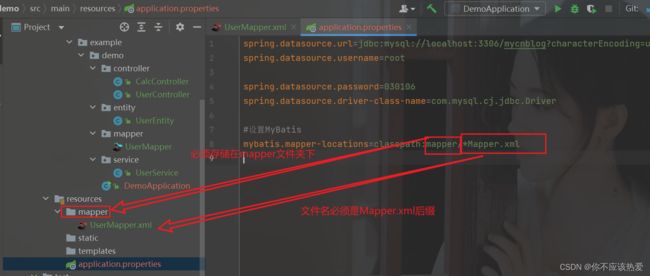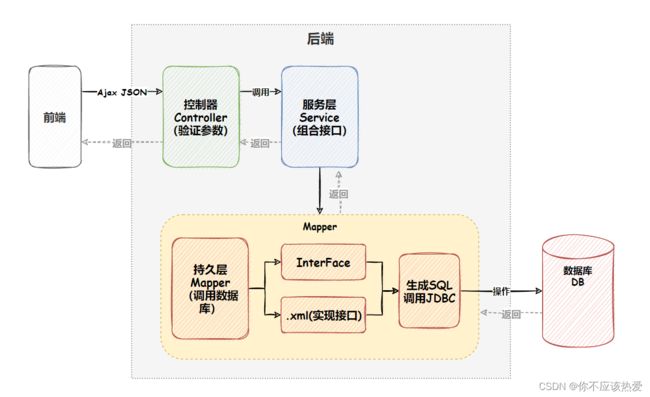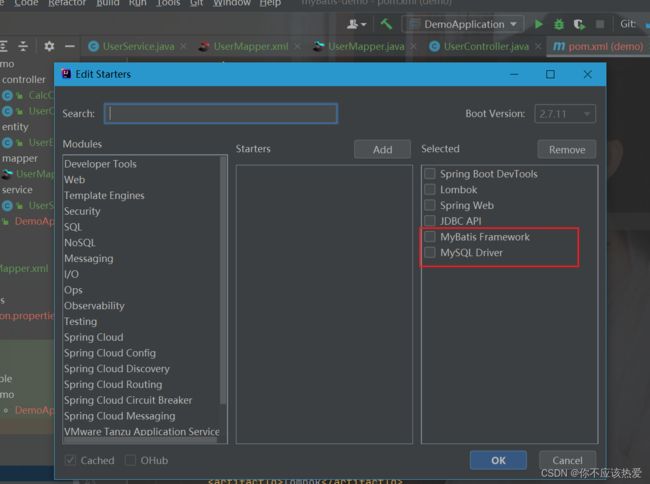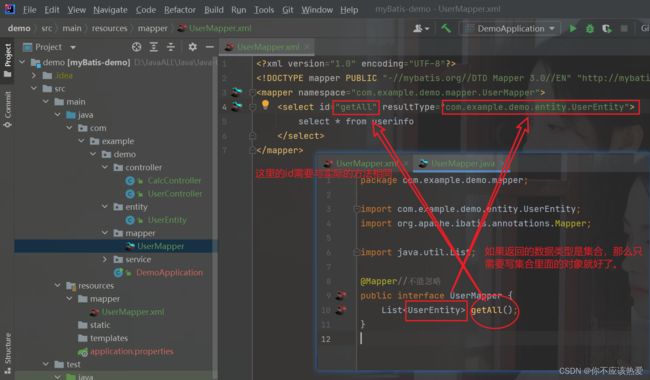MyBatis快速入门
目录
一、什么是MyBatis
二、MyBatis的学习要领
三、搭建第一个MyBatis
3.1 创建数据库和表
3.2 添加MyBatis框架支持
3.2.1 老项目添加MyBatis
3.2.2 新项目去添加MyBatis
3.3 设置MyBatis配置信息
3.3.1 设置数据库连接的相关信息
3.3.2 设置MyBatis xml保存路径 和 XML命名规范
3.4 MyBatis模式开发
3.4.1 添加用户实体类
3.4.2 添加Mapper接口
3.4.3 添加UserMapper.xml
3.4.3 Service层
3.4.4 Controller层
3.4.5 使用PostMan进行测试
一、什么是MyBatis
MyBatis 是⼀款优秀的持久层框架,它⽀持⾃定义 SQL、存储过程以及⾼级映射。MyBatis 去除了⼏乎所有的 JDBC 代码以及设置参数和获取结果集的⼯作。MyBatis 可以通过简单的 XML 或注解来配置和映射原始类型、接⼝和 Java POJO(Plain Old Java Objects,普通⽼式 Java 对象)为数据库中的记录。
简单来说 MyBatis 是更简单完成程序和数据库交互的⼯具,也就是更简单的操作和读取数据库⼯具。
二、MyBatis的学习要领
MyBatis学习只分为两部分:
- 配置MyBatis开发环境
- 使用MyBatis模式和语法操作数据库
三、搭建第一个MyBatis
开始搭建MyBatis之前,我们先来看看MyBatis在整个框架中的定位,框架交互流程图:
我们知道,MyBatis是ORM框架(Object Relational Mapping)即对象关系映射。
在⾯向对象编程语⾔中,将关系型数据库中的数据与对象建⽴起映射关系,进⽽⾃动的完成数据与对象的互相转换:
ORM将数据库映射为对象:
- 数据库表(table)--> 类(class)
- 记录(record,⾏数据)--> 对象(object)
- 字段(field) --> 对象的属性(attribute)
⼀般的 ORM 框架,会将数据库模型的每张表都映射为⼀个 Java 类。
也就是说使⽤ MyBatis 可以像操作对象⼀样来操作数据库中的表,可以实现对象和数据库表之间
的转换,接下来我们来看 MyBatis 的使⽤吧。
3.1 创建数据库和表
接下来我们要实现的功能是:使⽤ MyBatis 的⽅式来读取⽤户表中的所有⽤户,我们使⽤个⼈博
客的数据库和数据包,具体 SQL 如下。
-- 创建数据库
drop database if exists mycnblog;
create database mycnblog DEFAULT CHARACTER SET utf8mb4;
-- 使用数据数据
use mycnblog;
-- 创建表[用户表]
drop table if exists userinfo;
create table userinfo(
id int primary key auto_increment,
username varchar(100) not null,
password varchar(32) not null,
photo varchar(500) default '',
createtime timestamp default current_timestamp,
updatetime timestamp default current_timestamp,
`state` int default 1
) default charset 'utf8mb4';
-- 创建文章表
drop table if exists articleinfo;
create table articleinfo(
id int primary key auto_increment,
title varchar(100) not null,
content text not null,
createtime timestamp default current_timestamp,
updatetime timestamp default current_timestamp,
uid int not null,
rcount int not null default 1,
`state` int default 1
)default charset 'utf8mb4';
-- 创建视频表
drop table if exists videoinfo;
create table videoinfo(
vid int primary key,
`title` varchar(250),
`url` varchar(1000),
createtime timestamp default current_timestamp,
updatetime timestamp default current_timestamp,
uid int
)default charset 'utf8mb4';
-- 添加一个用户信息
INSERT INTO `mycnblog`.`userinfo` (`id`, `username`, `password`, `photo`, `createtime`, `updatetime`, `state`) VALUES
(1, 'admin', 'admin', '', '2021-12-06 17:10:48', '2021-12-06 17:10:48', 1);
-- 文章添加测试数据
insert into articleinfo(title,content,uid)
values('Java','Java正文',1);
-- 添加视频
insert into videoinfo(vid,title,url,uid) values(1,'java title','http://www.baidu.com',1);3.2 添加MyBatis框架支持
添加 MyBatis 框架⽀持分为两种情况:⼀种情况是对⾃⼰之前的 Spring 项⽬进⾏升级,另⼀种情况是创建⼀个全新的 MyBatis 和 Spring Boot 的项⽬,下⾯我们分别来演示这两种情况的具体实现。
3.2.1 老项目添加MyBatis
如果是在老项目中添加新增功能,添加框架支持:
org.mybatis.spring.boot
mybatis-spring-boot-starter
2.1.4
mysql
mysql-connector-java
5.1.38
runtime
添加了 MyBatis 之后,为什么还需要添加 MySQL 驱动呢?
因为MyBatis 就像⼀个平台(类似淘宝),⽽数据库相当于商家有很多种,不⽌有 MySQL,还有 SQLServer、 MariaDB等等,就像叫人买东西一样,不能告诉只告诉别人买这个东西,需要告诉别人具体到哪个地方去买。
3.2.2 新项目去添加MyBatis
完成了框架和驱动的安装,运行程序时,你会发现程序报错了。
这是因为你只告诉了程序要连接Mysql而没有告诉程序Mysql的具体信息,比如存储位置,密码等。这就好比你叫张三去找李四,可是李四到底在哪呢?如果没有人告知,程序是无法判断的。
3.3 设置MyBatis配置信息
此步骤需要进行两项配置,数据库连接字符串设置和MyBatis的XML文件配置。
3.3.1 设置数据库连接的相关信息
如果是application.properties 添加如下内容;
spring.datasource.url=jdbc:mysql://localhost:3306/mycnblog?characterEncoding=utf8&useSSL=false
spring.datasource..username=root
spring.datasource.password=030106
spring.datasource.driver-class-name=com.mysql.cj.jdbc.Driver
#设置MyBatis
mybatis.mapper-locations=classpath:mapper/*Mapper.xml
需要注意的是:
如果使⽤ mysql-connector-java 是 5.x 之前的使⽤的是“com.mysql.jdbc.Driver”,如果是⼤于 5.x
使⽤的是“com.mysql.cj.jdbc.Driver”。
3.3.2 设置MyBatis xml保存路径 和 XML命名规范
#设置MyBatis
mybatis.mapper-locations=classpath:mapper/*Mapper.xml分析:classpath代表的是当前项目的根路径,mapper代表的是所有关于MyBatis的配置文件会放在这里,*Mapper.xml代表的是所有与MyBatis相关的xml文件都命名为某某某Mapper,xml。
3.4 MyBatis模式开发
主要是由两部分组成:
- interface:让其他层可以注入使用的接口
- mybatis:xml -> 具体实现sql (可以理解为是上面interface的实现)
接口和XML文件的关系
- 通过接口和 XML 文件的映射关系,实现了接口中的方法与 XML 文件中的 SQL 语句的绑定。
- 当调用接口的方法时,MyBatis会根据方法的名称和参数类型找到对应的XML文件中的SQL语句,并执行该SQL语句。
- XML文件中的SQL语句可以直接调用数据库操作,也可以通过映射配置将结果集映射到对象中。
为什么MyBatis要这么麻烦的定义一个接口和一个xml文件才能实现执行sql的功能呢?
:因为实际开发的过程中,SQL语句往往是比较复杂的,如果写在Java的类中不太合适的,因此采用了接口+XML文件的形式。
下面按照开发的工程思路,也就是下面的流程来实现MyBatis查询用户的功能:
实现interface和xml文件时候需要注意格式要与配置文件下所书写的格式相同:
3.4.1 添加用户实体类
package com.example.demo.entity;
import lombok.Data;
import java.time.LocalDateTime;
@Data
public class UserEntity {
private Integer id;
private String username;
private String password;
private String photo;
private LocalDateTime createTime;
private LocalDateTime updateTime;
private Integer state;
}
需要注意:这里的属性名最好与字段名保持一致,因为这样MyBatis可以自动实现关系的映射。
3.4.2 添加Mapper接口
在添加该接口之前,我们先来认识一下@Mapper注解:
: @Mapper用于标识一个接口或类是MyBatis的映射器, 并将其注册为String的Bean,这样就可以在使用这个映射器的地方,可以通过依赖注入的方式直接使用它,而无需手动创建实例。
package com.example.demo.mapper;
import com.example.demo.entity.UserEntity;
import org.apache.ibatis.annotations.Mapper;
import java.util.List;
@Mapper//不能忽略
public interface UserMapper {
List getAll();
} 3.4.3 添加UserMapper.xml
需要注意的是namespace所写的接口需要与实际实现的接口保持一致:
UserMapper.xml 查询所有用户的具体实现SQL:
需要这里这里id与resultType要与接口中的方法相等。
以下是对以上标签的说明:
标签:需要指定 namespace 属性,表示命名空间,其值为 mapper 接⼝的全限定名,包括全包名.类名。
按照标准的分层结构,需要Controller层和Service层,因此我们需要完成Service层和Controller层的编写。
3.4.3 Service层
服务层的代码如下:
package com.example.demo.service;
import com.example.demo.entity.UserEntity;
import com.example.demo.mapper.UserMapper;
import org.springframework.beans.factory.annotation.Autowired;
import org.springframework.stereotype.Service;
import java.util.List;
@Service
public class UserService {
@Autowired
private UserMapper userMapper;
public List getAll() {
return userMapper.getAll();
}
}
可能有人会好奇:明明UserMapper是一个接口,@Autowired为什么可以让接口注入到当前对象中?
当我们在类中使用@Autowired注解注入 MyBatis 的接口时,实际上注入的是 MyBatis 自动生成的代理对象。这个代理对象实现了接口定义的方法,并能够与数据库进行交互。
3.4.4 Controller层
package com.example.demo.controller;
import com.example.demo.entity.UserEntity;
import com.example.demo.service.UserService;
import org.springframework.beans.factory.annotation.Autowired;
import org.springframework.web.bind.annotation.RequestMapping;
import org.springframework.web.bind.annotation.RestController;
import java.util.List;
@RequestMapping("/user")
@RestController
public class UserController {
@Autowired
private UserService userService;
@RequestMapping("/getAll")
public List getAll() {
return userService.getAll();
}
}






